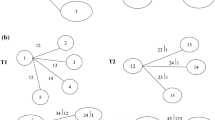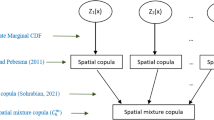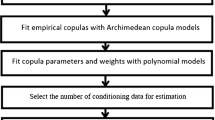Abstract
A real-world mining application of pair-copulas is presented to model the spatial distribution of metal grade in an ore body. Inaccurate estimation of metal grade in an ore reserve can lead to failure of a mining project. Conventional kriged models are the most commonly used models for estimating grade and other spatial variables. However, kriged models use the variogram or covariance function, which produces a single average value to represent the spatial dependence for a given distance. Kriged models also assume linear spatial dependence. In the application, spatial pair-copulas are used to appropriately model the non-linear spatial dependence present in the data. The spatial pair-copula model is adopted over other copula-based spatial models since it is better able to capture complex spatial dependence structures. The performance of the pair-copula model is shown to be favorable compared to a conventional lognormal kriged model.











Similar content being viewed by others
References
Aas, K., Czado, C., Frigessi, A., & Bakken, H. (2009). Pair-copula constructions of multiple dependence. Insurance: Mathematics and Economics, 44(2), 182–198.
Bárdossy, A. (2006). Copula-based geostatistical models for groundwater quality parameters. Water Resources Research, 42(11), W11416.
Bárdossy, A., & Li, J. (2008). Geostatistical interpolation using copulas. Water Resources Research, 44(7), W07412.
Bedford, T., & Cooke, R. M. (2002). Vines: A new graphical model for dependent random variables. The Annals of Statistics, 30(4), 1031–1068.
Boardman, R. C., & Vann, J. E. (2011). A review of the application of copulas to improve modelling of non-bigaussian bivariate relationships (with an example using geological data). In F. Chan, D. Marinova, & R. S. Anderssen (Eds.), Proceedings of the 19th International Congress on Modelling and Simulation (MODSIM2011) (pp. 627–633). Perth: Modelling and Simulation Society of Australia and New Zealand (MSSANZ). http://www.mssanz.org.au/modsim2011/A9/boardman.pdf.
Diggle, P. J., & Ribeiro, P. J. (2007). Classical parameter estimation. Model-based geostatistics (pp. 99–133). New York: Springer.
Erhardt, T. M., Czado, C., & Schepsmeier, U. (2015a). R-vine models for spatial time series with an application to daily mean temperature. Biometrics, 71(2), 323–332.
Erhardt, T. M., Czado, C., & Schepsmeier, U. (2015b). Spatial composite likelihood inference using local C-vines. Journal of Multivariate Analysis, 138, 74–88.
Gaetan, C., & Guyon, X. (2010). Second-order spatial models and geostatistics. Spatial statistics and modeling (pp. 1–52). New York: Springer.
Genest, C., & Rivest, L. (1993). Statistical inference procedures for bivariate Archimedian copulas. Journal of the American Statistical Association, 88(423), 1034–1043.
Getis, A. (2007). Reflections on spatial autocorrelation. Regional Science and Urban Economics, 37(4), 491–496.
Gräler, B. (2014). Modelling skewed spatial random fields through the spatial vine copula. Spatial Statistics, 10, 87–102.
Gräler, B., & Appel, M. (2015). ‘spcopula’. http://r-forge.r-project.org/projects/spcopula/.
Gräler, B., & Pebesma, E. (2011). The pair-copula construction for spatial data: A new approach to model spatial dependency. Procedia Environmental Sciences, 7, 206–211.
Haff, I. H., Aas, K., & Frigessi, A. (2009). On the simplified pair-copula construction-simply useful or too simplistic? Journal of Multivariate Analysis, 101(5), 1296–1310.
Haslauer, C. P., Li, J., & Bárdossy, A. (2010). Application of copulas in geostatistics. In P. M. Atkinson & C. D. Lloyd (Eds.), geoENV VII-geostatistics for environmental applications (pp. 395–404). Berlin: Springer.
Joe, H. (1996). Families of m-variate distributions with given margins and m(m-1)/2 bivariate dependence parameters. In L. Riischendorf, B. Schweizer, & M. D. Taylor (Eds.), Distributions with fixed marginal and related topics (pp. 120–141)., Lecture notes-monograph series Kolkata: Institute of Mathematical Statistics.
Journal, A. G., & Alabert, F. (2007). Non-Gaussian data expansion in the Earth Sciences. Terra Nova, 1(2), 123–134.
Kazianka, H., & Pilz, J. (2010). Copula-based geostatistical modeling of continuous and discrete data including covariates. Stochastic Environmental Research and Risk Assessment, 24(5), 661–673.
Kazianka, H., & Pilz, J. (2011). Bayesian spatial modeling and interpolation using copulas. Computers & Geosciences, 37(3), 310–319.
Khosrowshahi, S., & Shaw, W. (2001). Conditional simulation for resource characterization and grade control. In A. C. Edwards (Ed.), Mineral Resource and Ore Reserve Estimation - The AusIMM Guide to Good Practice. Australasian Institute of Mining and Metallurgy (AusIMM) (pp. 285–292).
Kurowicka, D., & Cooke, R. (2006). Uncertainty analysis with high dimensional dependence modelling. Chichester: Wiley.
Li, J. (2010). Application of copulas as a new geostatistical tool. Ph.D dissertation. Institute for Water and Environmental System Modeling. University of Stuttgart. doi:10.18419/opus-332
Marchant, B. P., Saby, N. P. A., Jolivet, C. C., Arrouays, D., & Lark, R. M. (2011). Spatial prediction of soil properties with copulas. Geoderma, 162(3–4), 327–334.
Mclennan, J. A., & Deutsch, C. V. (2004). Conditional non-bias of geostatistical simulation for estimation of recoverable reserves. CIM Bulletin, 97(1080), 68–72.
Musafer, G. N., & Thompson, M. H. (2016a). Non-linear optimal multivariate spatial design using pair-copulas. Stochastic Environmental Research and Risk Assessment. doi:10.1007/s00477-016-1307-6.
Musafer, G. N., & Thompson, M. H. (2016b). Optimal adaptive sequential spatial sampling of soil using pair-copulas. Geoderma, 271, 124–133.
Musafer, G. N., Thompson, M. H., Kozan, E., & Wolff, R. C. (2013). Copula-based spatial modelling of geometallurgical variables. In S. Dominy (Ed.), Proceedings of The Second AusIMM International Geometallurgy Conference (GeoMet2013) (pp. 239–246). Brisbane: Australasian Institute of Mining and Metallurgy (AusIMM).
Nelsen, R. B. (2006). An introduction to copulas. New York: Springer.
Peattie, R., & Dimitrakopoulos, R. (2013). Forecasting recoverable ore reserves and their uncertainty at Morila Gold Deposit, Mali: An efficient simulation approach and future grade control drilling. Mathematical Geosciences, 45(8), 1005–1020.
R Core Team. (2016). R: A language and environment for statistical computing. R Foundation for Statistical Computing. Vienna. https://www.r-project.org/.
Seo, D. J. (2013). Conditional bias-penalized kriging (CBPK). Stochastic Environmental Research and Risk Assessment, 27(1), 43–58.
Sklar, A. (1959). Fonctions de répartition á n dimensions et leurs marges. Publications de l’Institut de Statistique de L’Université de Paris, 8, 229–231.
Trivedi, P. K., & Zimmer, D. M. (2007). Copula modeling: An introduction for practitioners. Boston: Now.
Vann, J., & Guibal, D. (2001). Beyond ordinary kriging: An overview of non-linear estimation. In A. C. Edwards (Ed.), Mineral resource and ore reserve estimation-the AusIMM guide to good practice (pp. 249–256). Carlton: Australasian Institute of Mining and Metallurgy (AusIMM).
Acknowledgements
This research was funded by the Australian Government’s Cooperative Research Centre for Optimising Resource Extraction Grant P3C-030. The authors thank the reviewers for their comments and guidance, which greatly improved discussion and practical aspects of the application.
Author information
Authors and Affiliations
Corresponding author
Rights and permissions
About this article
Cite this article
Musafer, G.N., Thompson, M.H., Kozan, E. et al. Spatial Pair-Copula Modeling of Grade in Ore Bodies: A Case Study. Nat Resour Res 26, 223–236 (2017). https://doi.org/10.1007/s11053-016-9314-3
Received:
Accepted:
Published:
Issue Date:
DOI: https://doi.org/10.1007/s11053-016-9314-3




